Leaving Certificate Engineering
Machining Tool Forces
Home
There
are three forces acting on a cutting tool
When three forces are present during a cutting operation it is
called Orthogonal Cutting.
When two forces are present during a cutting operation it is
called Oblique Cutting.
The Forces Graph
indicates the relative sizes of the forces present during a typical cutting operation.
Cutting Tool angles are
important and a comparison can be made between this an the action of a knife peeling an
apple. It is easier for the knife to cut "slide" through an apple if the wedge
angle is kept small
Forces
Graph
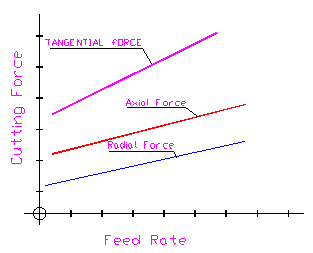 |
The graph indicates that the three
forces Tangential, Radial & Axial are different.
The largest
force is Tangential which tends to deflect the tool.
The Axial force is next and this resists
movement of the cutter towards the chuck
The smallest
force is Radial and can be greatly reduced by keeping the
plan approach angle small.
|
Tangential
Force
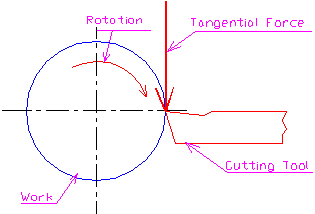 |
The largest
force is Tangential which tends to deflect the cutting tool
downward.
The reason it is called Tangential is that it
acts along a line which is a tangent to the work as indicated.
The Tangential force is usually the greatest
of the three.
The cutter must be strong and held
securely to resist breaking as a result of this force.
|
Radial
Force
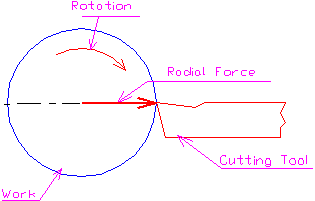 |
The smallest
force is radial and can be greatly reduced by keeping the
plan approach angle small.
The cutter must be strong and held
securely to resist breaking as a result of this force.
The reason it is called radial is that it
acts from the centre of the work towards the cutter as indicated.
|
Axial Force
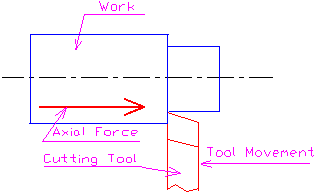 |
The Axial force acts parallel to the axis of the work-piece.
It resists movement of the cutter
towards the spindle.
This axial force is usually less than the
tangential force.
This can be reduced by keeping the feed rate
low.
|
Cutting
Tool Angles
A constant compromise is taking place when
deciding the correct angles for a cutting tool. The angles are dependent mainly on the
type of material being cut and the shape of the material. In general it is best to keep
the Wedge angle as large as possible but good cutting will not take place without having
sufficient rake and clearance.
The Wedge or Tool angle. This is the visible angle when we look at any cutting tool and gives the
cutter its strength. The greater the wedge angle the stronger the cutter but it is more
difficult to push into the work-piece. The
Rake angle. This is ground to suit the material being cut
and the greater the rake the easier it is to cut but the weaker the cutting tool. An angle
of 20º is used for mild steel and an angle of 5º is used for cast
iron. The Clearance. If the flank of the cutting tool came into contact with the work the
cutting edge could not take of a chip. The larger the clearance the weaker the cutting
tool.
Wedge / Tool
Angles
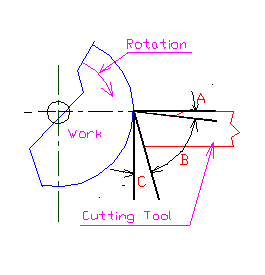 |
The simplest form of a cutting tool has three
main angles:- Wedge, Rake and
Clearance.
The Wedge. This
is often called the tool angle and is indicated by "B"
The Rake. This
is indicated by "A" and the alows the chip to flow away.
The Clearance.
This ensures that only the cutting edge touches the work-piece "C"
|
| Paddy Keays Engineering Teacher |
Cresent College Comprehensive Limerick Ireland |
| Last updated 10th February 2004. |
Comments to:- email paddykeays@eircom.net |
|





